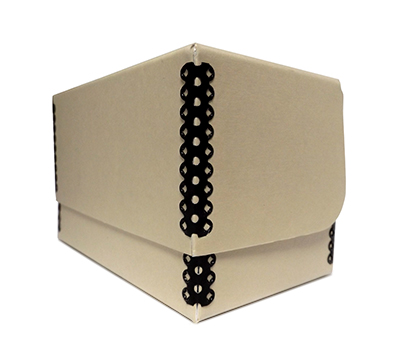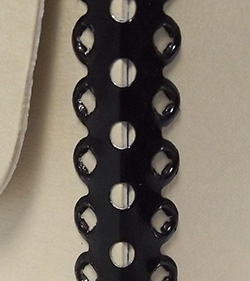Hand Assembled Metal Edge Boxes in the UK
Boxes worth waiting for
Our metal edged boxes are hand assembled to order at our manufacturing facility in South Norfolk, England. Renowned for their quality, our metal edged boxes are used and trusted in museums and archives worldwide. If you order a metal edge box from us, it is made for you, not sat on a shelf, not shipped in, not out-sourced. We do this to ensure that your box order meets our rigorous quality controls. Our boxes are in-stock, but do require hand assembly when ordered. We will always work with our customers to achieve deadlines, generally smaller orders are processed over the course of 2-3 days.

Why metal edge boxes?
Constructed of high quality acid-free board, our metal edge boxes have no adhesives to dry-out and fail. The metal edge is crimped into the board forming a strong reliable edge which will last for decades in the correct environment.
The metal edge provides a stacking strength that exceeds that of a standard glued box, meaning empty or partially filled boxes can safely be stacked under heavier loaded boxes.
Still not convinced metal edges are the way forward? Some glues can, as they dry, off-gas. This means that the contents of a glued box could potentially be exposed to damaging acidity – even if the box itself is acid-free.
Buffered or not buffered?
The majority of our metal edge boxes are lined with white lignin-free paper and buffered with 3% calcium carbonate for an alkaline reserve to protect contents against migrant acidity and atmospheric sulphur. This means that if acids are present in the shelving materials, neighbouring boxes or items, or even in the air (such as through pollution), the contained items are protected. The buffer neutralises damaging acids before they reach the stored contents. For more information on the merits of 'Buffered' and 'Unbuffered' storage see our blog post here.

A PAT on the back
Most of our metal edge boxes have also passed the PAT test, look for the PAT passed symbol. This means the materials used have been certified by the Image Permanence Institute as safe to store photographic materials.
The ISO definition against which materials the PAT test is evaluated reads as follows “This International Standard evaluates possible chemical interactions between enclosures with processed silver-gelatin, colour (dye-gelatin), inkjet prints made with dye-based and pigment-based inks, thermal dye diffusion transfer (“dye sub”) prints, digitally printed dye-diffusion-transfer prints, liquid- and dry-toner xerographic prints, liquid-toner electrostatic prints, and diazo images after long-term storage.”
The box board also provides protection from damaging UV light which can be extremely problematic for print and textile archives.

Don’t the metal edges rust?
Our simple answer is, if the metal edges are in an environment where they could corrode, you have much more serious storage environment issues to contend with.
Our boxes are high specification acid-free archival storage enclosures for precious artefacts and documents. If it’s damp enough to rust the metal edge, the contents inside the box, or any items stored in that environment will have been damaged too (probably well before the metal edge shows any signs of corrosion). Our edging material is powder coated to prevent exterior corrosion but are not made from stainless material. Why isn’t this a problem? Our boxes are designed for and used by thousands of museums and archives worldwide to store valuable artefacts, the very items you would not want to expose to to excess moisture. Correct environmental control is the key here, if you have your storage facility correctly controlled, rust is not an issue.
Our most popular metal edged archival boxes; Archival Paper storage boxes for A1, A2, A3, A4 and A5, Clamshell Storage Boxes, Large Textile Storage boxes - or to see the full range of metal edge boxes click here.